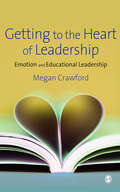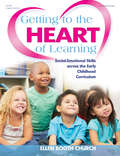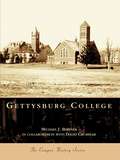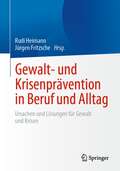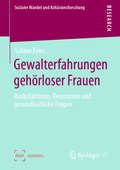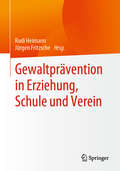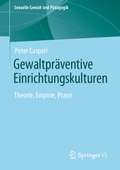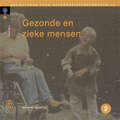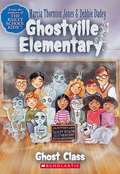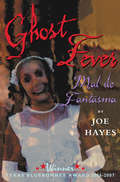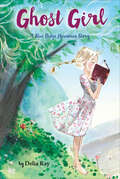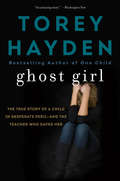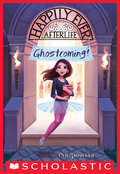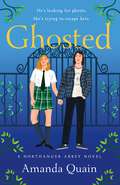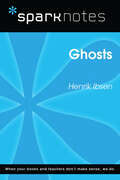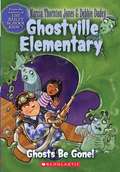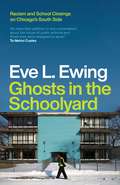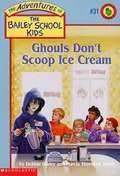- Table View
- List View
Getting to Work on Summer Learning: Recommended Practices for Success
by Laura Zakaras Catherine H. Augustine Jennifer Sloan Mccombs Heather L. SchwartzRAND is conducting a longitudinal study that evaluates the effectiveness of voluntary summer learning programs in reducing summer learning loss, which contributes substantially to the achievement gap between low- and higher-income students. Based on evaluations of programs in six school districts, this second report in a series provides research-based advice for school district leaders as they create and strengthen summer programs.
Getting to the Core of English Language Arts, Grades 6-12: How to Meet the Common Core State Standards with Lessons from the Classroom
by Vicky M. Giouroukakis Dr Maureen ConnollyDesign effective CCSS-aligned lessons for secondary students If you want to revamp your secondary English Language Arts curriculum to reflect the Common Core State Standards, this book is the perfect resource. The authors move the implementation of the CCSS for ELA from the abstract to the concrete by providing adaptable, exemplar lesson plans in each of the CCSS strands: reading, writing, speaking and listening, and language. Each lesson template includes: Intended grade level band, timeline, and the type of student writing involved Connections to supporting theory, including the Backward Design model Variations to differentiate lessons for diverse student populations Ways to link the lesson to technology and service learning Reproducible handouts
Getting to the Core of Literacy for History/Social Studies, Science, and Technical Subjects, Grades 6–12
by Vicky M. Giouroukakis Dr Maureen ConnollyLiteracy—it’s not just for English teachers anymore! The new Common Core English Language Arts Standards aren’t just for English teachers. Fluent reading and writing are critically important to the study of history/social studies, science, and technical subjects, too. In this practical resource, you’ll use teacher-tested, CCSS-based lessons as models—and follow the principles of the Backward Design approach to curriculum development to set and meet your goals. Each lesson template includes <p><p> The teaching strategies you’ll utilize <p> Ways to incorporate technology and media <p> Variations for differentiation and interdisciplinary connections <p> Links to the work of major educational theorists
Getting to the Heart of Leadership: Emotion and Educational Leadership
by Megan Crawford'This book makes an important contribution to the literature on educational leadership and should help to shift the emphasis from rational and accountability-related models to an explicit recognition of the importance of emotions to effective leadership' - Educational Management Administration and Leadership '[This book] contains a wealth of case studies and vignettes to help leaders be more aware of the ways in which emotion impacts on their practice, and to develop a productive and sustainable set of emotional responses, experiences and leadership tools' - Headteacher Update 'This is a highly readable and engaging introduction to both the importance and power of emotions in the life and work of headteachers. While leaders' emotions have been badly neglected in the literature, the rich body of evidence the author shares with readers indicates how central such emotions are to sustaining improvement efforts in schools.' - Professor Ken Leithwood, Ontario Institute for Studies in Education (OISE), University of Toronto, Canada 'The affective side of leadership is often forgotten as school heads and leaders strive for excellence and accountability. This extremely important book brings to the forefront the emotional attachments of leadership, the interpersonal relationships, and self-awareness that are at the core of leadership action and decision making. The case stories and reviews of multiple perspectives and theories provide the reader with a rich and essential resource' - Ellen B. Goldring, Professor of Education Policy and Leadership, Vanderbilt University '...The book is framed to illuminate how headteachers experience, and talk about, emotion and meaning in their daily interactions, and sets out to understand how emotion impacts on their leadership.' (author's introduction) Understanding the close relationship between leadership and emotion is essential for school leaders in creating, modifying and sustaining the emotional coherence of the whole school. Megan Crawford aims to help school leaders understand why emotion is such a powerful component of leadership. The author examines how school leaders experience emotion and meaning in their daily interactions, and presents a reflective journey, concentrating on the personal side of school leadership. The author shows how school climate depends on the personal emotional quality of the leader and his/her interface with other social relationships in the school, covering areas such as difficult people and situations, shame, loss and drawing on primary and secondary case studies, school leaders' reflections and the influence of their life history, school context and emotional epiphanies. This book is for practising educational leaders and managers, tutors and students on Masters courses, EdD courses, and on programmes such as the National Professional Qualification for Headship, its equivalent for Children's centres, and other national programmes in educational leadership and management
Getting to the Heart of Learning: Social-Emotional Skills across the Early Childhood Curriculum
by Ellen Booth ChurchThe best learning emerges in a classroom community where children feel accepted and appreciated for their ideas and actions. Through the activities in Getting to the Heart of Learning, Ellen Booth Church shows teachers and caregivers how easy it is to foster children's sense of curiosity through group explorations that promote social connection and positive development. With step-by-step instructions, Getting to the Heart of Learning weaves social-emotional learning into activities that support math, science, literacy, and motor skills. Rather than adding in activities throughout the day, these explorations integrate social-emotional learning across the curriculum through group involvement and building community. Learn how to strengthen home-to-school connections, too, with easy strategies that help families develop a shared vision for student's social-emotional and academic success.
Gettysburg College
by Michael J. Birkner David CrumplarGettysburg College is the oldest Lutheran affiliated college in the United States. At its founding in 1832--a time of social ferment and advancing democracy--college leaders emphasized a liberal arts mission. Pennsylvania College, as it was known until 1919, numbers among its graduates many clergy, lawyers, and physicians, as well as politicians, social gospel advocates, scientists, business executives, and university presidents. Although the college has grown considerably since World War II, its mission has remained consistent: devotion to the pursuit of truth and active citizenship. Through historic photographs, Gettysburg College documents significant themes in the college's history: an expanding campus, the emergence and influence of intercollegiate athletic teams and social fraternities, curricular change, and key national events that affected the college, none of the latter more important than the Battle of Gettysburg and two world wars. Always respected for its academic program, Gettysburg College has in the past generation diversified its faculty and student body, expanded its interdisciplinary programs, and gained in reputation as a leading national liberal arts college.
Gewalt- und Krisenprävention in Beruf und Alltag: Ursachen und Lösungen für Gewalt und Krisen
by Rudi Heimann Jürgen FritzscheDer Herausgeberband gibt einen anwenderorientierten Überblick zu Ursachen und Entwicklungen von Bedrohungen, Gewalt und daraus entstehender Krisen im beruflichen Kontext und im Alltag. Ein interdisziplinäres Autorenteam stellt neben den Grundlagen die wichtigsten Methoden zur Bewältigung sich entwickelnder und bereits offener Gewalt- und Krisensituationen vor. Der Schwerpunkt liegt im Anwendungsteil auf angemessener konfliktfreier Lösung und der konsequenten Verfolgung alternativer Möglichkeiten, wenn eine konfliktfreie Bewältigung nicht mehr möglich ist. Sicherheitskonzepten und praktikablen Deeskalationsmodellen wird ebenso wie massiven Krisen ein Platz eingeräumt.Die Zielgruppen sind Führungskräfte und Mitarbeitende in öffentlichen Verwaltungen, Justiz, Schulen, Geldinstituten, im Gesundheitswesen, öffentlichen Personennahverkehr oder in vergleichbaren Einrichtungen, Verantwortliche wie Sicherheits- und Präventionsbeauftragte in diesen Bereichen, Trainer für Sicherheitsthemen und Interessierte im privaten Umfeld.Die Herausgeber sind Rudi Heimann, Leitender Polizeidirektor, Experte für Gewaltschutz und Krisenbewältigung, Keynote Speaker und Leiter einer Zentralen Ausländerbehörde, sowieDr. Jürgen Fritzsche, sportwissenschaftlicher Berater, Coach und Gewaltschutztrainer (EXperts for TRAining), ehemaliger Bundeslehrwart des Deutschen Karateverbandes, international tätiger Dozent und Technischer Direktor des luxemburgischen Karateverbandes.Empfehlung der DGUV“Im vorliegenden Buch ist es gelungen, die aktuellen Erkenntnisse zum Thema Gewalt umfassend und gleichzeitig alltagsnah aufzubereiten. Eine besondere Stärke liegt in der Interdisziplinarität […], die Einblicke in verschiedenste wissenschaftliche Bereiche gewährt. Klare Handlungsempfehlungen schützen bei einem potentiell gewalttätigen Konflikt vor einer weiteren Eskalation.”Dr. Stefan HussyHauptgeschäftsführer der Deutschen Gesetzlichen Unfallversicherung (DGUV)
Gewalterfahrungen gehörloser Frauen: Risikofaktoren, Ressourcen und gesundheitliche Folgen (Sozialer Wandel und Kohäsionsforschung)
by Sabine FriesDie Erkenntnis, dass gehörlose Frauen von verschiedenen Formen von Gewalt und ihren Folgen genauso oder sogar weit häufiger betroffen sein können als andere Frauen, ist in der Öffentlichkeit kaum bekannt. Ein stark erhöhtes Risiko für Gewalterfahrungen ergibt sich bei gehörlosen Frauen vor allem aufgrund einer ausgeprägten gesellschaftlichen Isolation. Ein weiterer wesentlicher Risikofaktor für die im Vergleich zu Frauen mit und ohne Behinderungen überdurchschnittlich hohe Gewaltbetroffenheit gehörloser Frauen ist ihre häufig alternativlose Einbindung in die Gehörlosengemeinschaft. Dies verweist darauf, dass unsere Gesellschaft bislang daran gescheitert ist, gehörlose Menschen ausreichend zu integrieren, und diese so marginalisiert hat, dass sie von der Mehrheitsgesellschaft weitgehend unbemerkt zu Tätern und Opfern werden. Nicht zuletzt hat Gewalt gegen gehörlose Frauen komplexe und weitreichende gesundheitliche Folgen. Das Gesundheitssystem nimmt deshalb eine Schlüsselrolle für die Prävention, Weitervermittlung und Intervention bei Gewalt gegen gehörlose Frauen und ihre Kinder ein.
Gewaltprävention in Erziehung, Schule und Verein
by Rudi Heimann Jürgen FritzscheDie Sicherheit von Kindern im Zusammenhang mit dem Schutz vor Übergriffen und Gewalt ist ein Grundbedürfnis unserer Gesellschaft. Dieser Herausgeberband gibt einen präzisen Überblick zur Sozialerziehung von Kindern und Jugendlichen für alle Verantwortlichen, die im Rahmen ihrer beruflichen, ehrenamtlichen oder erzieherischen Tätigkeit die notwendigen Impulse setzen wollen und daran interessiert sind, wie sie diese erfolgreich vermitteln. Das Handbuch umfasst einen Grundlagen- und Präventionsteil.
Gewaltpräventive Einrichtungskulturen: Theorie, Empirie, Praxis (Sexuelle Gewalt und Pädagogik #9)
by Peter CaspariIn dem Buch werden günstige Voraussetzungen und Hindernisse für die Implementierung gewaltpräventiver Strukturen in pädagogischen Einrichtungen beschrieben. Der Begriff des „Schutzkonzepts“ wird dabei einer kritischen Betrachtung unterzogen. Als empirisch begründetes Präventionstool für pädagogische Einrichtungen wird das Instrument IPSE zur partizipativen Selbstevaluierung vorgestellt.
Gezinsvragenlijst (GVL) handleiding
by Prof. dr. van der Ploeg Prof. dr. ScholteDoel van de testDe GVL meet de kwaliteit van gezins- en opvoedingsomstandigheden van kinderen in de leeftijd van 4 t/m 18 jaar. Gezinsomstandigheden hebben grote invloed op de gedrags- en emotionele ontwikkeling van kinderen en jongeren. Wanneer zich in een gezin problemen voordoen, kan dit de sociaal emotionele ontwikkeling van kinderen ernstig verstoren. In de jeugdzorg is men er inmiddels van doordrongen dat het behandelen van alleen de jeugdige niet voldoende is, maar dat ook altijd aandacht voor het gezin noodzakelijk is. Gezinsvragenlijsten screenen de opvoedingsinvloed van het gezin meestal alleen via de ouder-kind relatie. Het gezin bestaat echter uit meerdere relaties: ook de relatie tussen de ouders onderling en tussen het gezin en haar omgeving zijn onderdeel van het gezinssysteem. De Gezinsvragenlijst meet deze meervoudige gezinsrelaties en screent zowel het opvoedgedrag van de ouders als het functioneren van het gezin als geheel. Afname brengt aan het licht waar het gezin eventueel tekort schiet, wat de risico’s zijn op problematisch gedrag bij een kind en waar de mogelijke oorzaken liggen van problemen in het gezin. Afname van de GVL verschaft aanknopingspunten voor interventies.ToepassingsmogelijkhedenScreening: screent het gezinsfunctioneren en spoort risicovolle pedagogische en gezinsomstandigheden op bij gezinnen met schoolgaande kinderen in het gewoon basisonderwijs, het speciaal basisonderwijs en het voortgezet onderwijs. Periodieke afname brengt het beloop van risicovolle gezins- en opvoedingsomstandigheden in beeld. Diagnose: bepaalt of doorverwijzing naar jeugdzorg nodig is. Geeft aanknopingspunten voor gezinsinterventies. Bepaalt de aard en de ernst van problemen in de gezins- en opvoedingssituatie. Behandeling: geeft aanknopingspunten voor interventies. Evalueert de voortgang en de effectiviteit van interventies. Wat meet de GVL?De GVL screent de relaties tussen de ouders en het kind, tussen de ouders onderling en tussen het gezin en haar omgeving. Daarnaast screent de GVL de context waarbinnen deze relaties zich afspelen: de organisatie van het gezin en de gezinsstructuur. De GVL bestaat uit vijf basisschalen die samen het totale gezinsfunctioneren vertegenwoordigen: • responsiviteit (de opvoedingsrelatie van de ouders met het kind)• communicatie (de communicatie van de ouders met het kind) • organisatie (de gezinscontext waarbinnen de gezinsrelaties plaatsvinden)• partnerrelatie (de onderlinge relatie tussen de ouders)• sociaal netwerk (de relaties van het gezin met de omgeving)Voor wie?De GVL wordt ingevuld door de ouders of opvoeders van het kind, of door personen die het kind en het gezin goed kennen. Maatschappelijk werkers, groepsleiders, psychologen, orthopedagogen en andere professionele hulpverleners kunnen de uitslagen van de test gebruiken ter taxatie van de gezins- en opvoedingssituatie van kinderen en gezinnen. Testuitslagen mogen echter alleen worden geïnterpreteerd door psychodiagnostisch geschoolde personen.Afname en scoringDe GVL bestaat uit 45 vragen. De afname duurt circa 30 minuten. Het invullen en scoren kan enerzijds handmatig plaatsvinden. U kunt de GVL ook geautomatiseerd afnemen en scoren met behulp van Testweb.Belangrijk: u kunt deze test alleen afnemen indien u over de GVL Handleiding beschikt.NormenInterpretatie van de scores vindt plaats door de scores van individuele respondenten te vergelijken met normen die het onderscheid tussen wel en geen problematiek weergeven. Voor de interpretatie worden in de handleiding de volgende normgegevens verstrekt:• Algemene bevolking• Klinische gezinnenMaterialen• GVL handleiding• GV
Gezonde en zieke mensen.
by J. De JongeIn dit boek wordt ingegaan op gezond functioneren en op ziek-zijn. Aspecten van gezondheidskunde, ziektekunde en anatomie-fysiologie worden in dit boek geïntegreerd. Dit gebeurt op een heldere manier, dicht bij het eigen (be)leven van de leerling. De stof wordt toegelicht aan de hand van voorbeelden en afbeeldingen. Theorie wordt alleen gegeven als de leerling dit in het toekomstig functioneren nodig heeft
Ghost Class (Ghostville Elementary #1)
by Debbie Dadey Marcia Thornton JonesIn this spooky new series from the creative team behind "The Adventures of the Bailey School Kids", Cassidy and Jeff discover there's a ghost class in the basement of their school.
Ghost Fever: Mal de Fantasma
by Joe HayesIn his classic bilingual style, Joe tells the story of a haunted house in a poor little town in Arizona. Nobody will rent that house because they know a ghost lives there. So the landlord tries to rents it out for free. Still nobody will rent it. That is, until Elena's father rents it. He doesn't believe in ghosts. Lucky for Elena that her grandmother knows all about the ways of ghosts. Elena, with the help of her grandmother, resolves the mystery of "ghost fever"--and learns a lesson about life.Joe Hayes, who lives in Santa Fe, is an award-winning storyteller renowned especially for his stories in Spanish and English.
Ghost Girl: A Blue Ridge Mountain Story (Blue Ridge Mountain Stories)
by Delia Ray"Nothing is...predictable...April's coming-of-age...is poignant, realistic, and somber, and reflective of the strength April has found within." Horn Book, Starred"Ray's loving attention to setting, character, and detail makes this debut special...based on real events and a real teacher." KIRKUS REVIEWS, starred review Kirkus Reviews, Starred"Ray sensitively captures the atmospheric flavor...treat[s] her characters as real, complex people...A warm but not sentimental coming-of-age story." THE BULLETIN OF THE CENTER FOR CHILDREN'S BOOKS The Bulletin of the Center for Children's Books"excellent portrayal...rises to the top....seamlessly incorporates historical facts into the narrative...engaging character...first-rate purchase for all libraries." SCHOOL LIBRARY JOUNRAL, STARRED REVIEW School Library Journal, Starred"fascinating historical detail...will haunt readers, especially since there's no patched-on happy solution to the poverty, anger and sorrow." BOOKLIST Booklist, ALA —
Ghost Girl: The True Story Of A Child In Desperate Peril - And A Teacher Who Saved Her
by Torey HaydenJadie never spoke. She never laughed, or cried, or uttered any sound. Despite efforts to reach her, Jadie remained locked in her own troubled world . . . until one remarkable teacher persuaded her to break her self-imposed silence.Nothing in all of Torey Hayden’s experience could have prepared her for the shock of what Jadie told her—a story too horrendous for Torey’s professional colleagues to acknowledge. Yet a little girl was living in a nightmare, and Torey responded in the only way she knew how—with courage, compassion, and dedication—demonstrating once again the tremendous power of love and the resilience of the human spirit.
Ghostcoming! (Happily Ever Afterlife #1)
by Orli ZuravickyLucy has just joined the afterlife, and as a brand-new ghost she's mostly see-through, not able to stand or sit normally, stuck in the ballet clothes she was wearing before she crossed over...and stuck in middle school. Can't a ghost get a break? But then the cutest (ghost) boy she's ever seen turns out to be her very own guide to school, and things start looking brighter. Maybe she's not quite solid yet, but Lucy is definitely going to make this the best afterlife ever!
Ghosted: A Northanger Abbey Novel
by Amanda QuainNever Have I Ever meets The X-Files in Amanda Quain's Ghosted, a fresh and funny update on the Jane Austen classic, Northanger Abbey.Hattie Tilney isn’t a believer. Yes, she’s a senior at America’s most (allegedly) haunted high school, Northanger Abbey. But ever since her paranormal-loving dad passed away, she’s hung up her Ghostbusters suit, put away the EMF detectors, and moved on. She has enough to worry about in the land of the living—like taking care of her younger brother, Liam, while their older sister spirals out and their mother, Northanger’s formidable headmistress, buries herself in work. If Hattie just tries hard enough and keeps that overachiever mask on tight through graduation, maybe her mom will finally notice her.But the mask starts slipping when Hattie’s assigned to be an ambassador to Kit Morland, who’s just transferred to Northanger on—what else—a ghost-hunting scholarship. The two are paired up for an investigative project on the school’s paranormal activity, and Hattie quickly strikes a deal: Kit will present whatever ghostly evidence he can find to prove that the campus is haunted, and Hattie will prove it’s not. But as they explore the abandoned tunnels and foggy graveyards of Northanger, Hattie starts to realize that Kit might be the kind of person who makes her want to believe in something—and someone—for the first time.With her signature wit and slow-burn romance, Amanda Quain turns another Austen classic on its head in this sparkling retelling that proves sometimes the ghosts are just a metaphor after all.
Ghosts (SparkNotes Literature Guide Series)
by SparkNotesGhosts (SparkNotes Literature Guide) by Henrik Ibsen Making the reading experience fun! Created by Harvard students for students everywhere, SparkNotes is a new breed of study guide: smarter, better, faster. Geared to what today's students need to know, SparkNotes provides: chapter-by-chapter analysis explanations of key themes, motifs, and symbols a review quiz and essay topics Lively and accessible, these guides are perfect for late-night studying and writing papers.
Ghosts Be Gone! (Ghostville Elementary #8)
by Debbie Dadey Marcia Thornton JonesIt's Career Day and Andrew, the class bully, wants to be a rich and famous ghost hunter. Will the Ghostville ghosts be toast? Or will Andrew get himself slimed?
Ghosts in the Schoolyard: Racism and School Closings on Chicago's South Side
by Eve L. Ewing“Failing schools. Underprivileged schools. Just plain bad schools.” That’s how Eve L. Ewing opens Ghosts in the Schoolyard: describing Chicago Public Schools from the outside. The way politicians and pundits and parents of kids who attend other schools talk about them, with a mix of pity and contempt. But Ewing knows Chicago Public Schools from the inside: as a student, then a teacher, and now a scholar who studies them. And that perspective has shown her that public schools are not buildings full of failures—they’re an integral part of their neighborhoods, at the heart of their communities, storehouses of history and memory that bring people together. Never was that role more apparent than in 2013 when Mayor Rahm Emanuel announced an unprecedented wave of school closings. Pitched simultaneously as a solution to a budget problem, a response to declining enrollments, and a chance to purge bad schools that were dragging down the whole system, the plan was met with a roar of protest from parents, students, and teachers. But if these schools were so bad, why did people care so much about keeping them open, to the point that some would even go on a hunger strike? Ewing’s answer begins with a story of systemic racism, inequality, bad faith, and distrust that stretches deep into Chicago history. Rooting her exploration in the historic African American neighborhood of Bronzeville, Ewing reveals that this issue is about much more than just schools. Black communities see the closing of their schools—schools that are certainly less than perfect but that are theirs—as one more in a long line of racist policies. The fight to keep them open is yet another front in the ongoing struggle of black people in America to build successful lives and achieve true self-determination.
Ghouls Don't Scoop Ice Cream (The Adventures of the Bailey School Kids #31)
by Debbie Dadey Marcia Thornton JonesThere are some pretty weird grown-ups living in Bailey City. But could the new worker at Burger Doodle with very pale skin and sad eyes really be a ghoul spying for a family of vampires?
Giant Lizards (Penguin Young Readers, Level 3)
by Ginjer L. ClarkeLeapin' lizards! Kids have always been fascinated by reptiles, both living and extinct. Now they'll learn all about lizards that lived with the dinosaurs and still roam the earth today. With clear, simple text and bright, bold artwork, this Level 3 Penguin Young Reader is perfect for the home and classroom!
Giant Pandas (Scholastic Reader, Level 2)
by AnnMarie AndersonLearn all about Pandas in this new Level 2 reader.A new Scholastic level 2 reader about cuddly, adorable pandas: what do they eat? What are their habitats like? What does it mean when we say pandas are an endangered species? Includes full color photographs and easy-to-read text.
Giants in the Earth (SparkNotes Literature Guide Series)
by SparkNotesGiants in the Earth (SparkNotes Literature Guide) by O.E. Rolvaag Making the reading experience fun! Created by Harvard students for students everywhere, SparkNotes is a new breed of study guide: smarter, better, faster.Geared to what today's students need to know, SparkNotes provides:chapter-by-chapter analysis explanations of key themes, motifs, and symbols a review quiz and essay topics Lively and accessible, these guides are perfect for late-night studying and writing papers.



